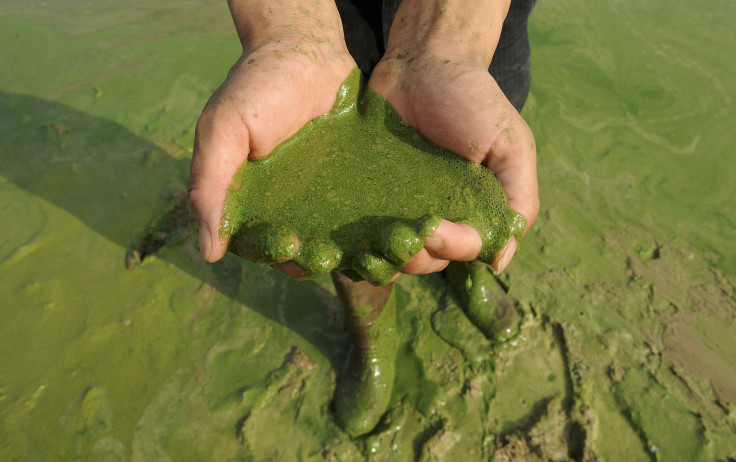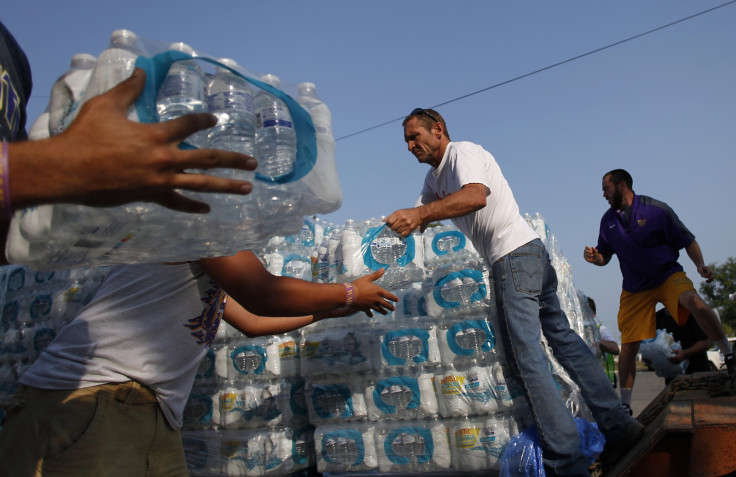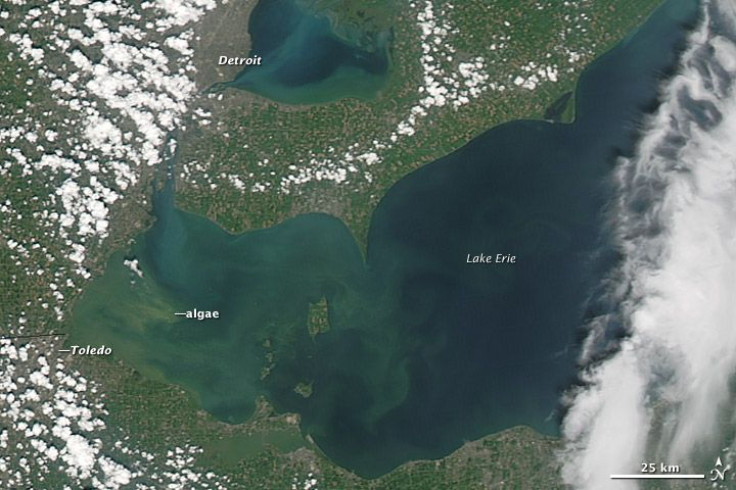Lake Erie Algae Bloom Crisis Is Putting Pressure On Ohio, Farm States To Tackle Agricultural Pollution Problems

On the shores of Lake Erie, the immediate sense of crisis has passed. Following the toxic algae that bloomed in the lake earlier this month, forcing residents of Toledo, Ohio to rely on bottled water for their drinking supply, authorities now offer assurances that the tap water is safe.
But a gnawing fear remains in communities along the lake. The algal bloom has intensified concerns about its apparent source -- pollution washing off surrounding fields in the form of fertilizer and manure. Not without reason, people worry that more outbreaks could emerge at any time.
“I’m still drinking bottled water,” said Jessica Morelli, a nursing mother who skipped showers the weekend of the tap water shutdown, worrying she’d get a skin infection that she could potentially pass on to her 8-month-old daughter. “People are still kind of leery. If it could make you so sick one day, how could it be normal so quickly again?”

Around the nation, similar worries have become a part of everyday life as communities grapple with growing volumes of pollution spilling into waterways from livestock and farming operations. Though talk of industrial pollution may summon images of belching smokestacks, the agricultural expanses producing meat, dairy, grains and vegetables are today so enormous that they can generate quantities of water pollution rivaling cities. Yet the rules governing this pollution still generally treat farming as something other than an industry.
The U.S. Environmental Protection Agency does not regulate agricultural runoff, leaving such effluent to be governed by local agencies whose philosophies and standards vary from state to state. State rules and enforcement are often lax, environmental policy experts assert, in part because pushback from agricultural lobbying interests, but also because of limited funding and staffing at regulatory agencies.
"The states to date have had a very ineffective response on what to do about this,” Brad Klein, a senior attorney at the Environmental Law and Policy Center in Chicago, told International Business Times. “We’re hoping that situations like Toledo provide a wake-up call that this could happen anywhere, and that it’s happening with increasing frequency.”
Last year alone, 20 states reported nearly 150 separate toxic algal blooms in lakes rivers and ponds, including 10 in Ohio and 50 in New York, according to National Wildlife Federation data. While industrial waste, sewage from septic tanks and lawn fertilizer also contribute to the problem, agriculture is the biggest source of the phosphorous and nitrogen that nurture harmful blooms. If ingested, certain types of algae-born toxins can cause fevers, vomiting and diarrhea. Direct skin contact can cause hives, blisters and rashes.
Scientists peg the increasing incidence of algae blooms to a mix of factors that seems set to intensify in coming years, ratcheting up the risk of more. Farmers are relying more on so-called dissolved phosphorous fertilizers, which they apply directly to the soil rather than till into the ground. Left on the surface, these fertilizers are more prone to being washed into surrounding waterways. Climate change threatens to bring more severe rainstorms, which would carry larger volumes of runoff into streams and overflowing sewer systems.
All of this is happening just as agriculture is growing in some states. In Ohio, sales of corn, soybeans, wheat, poultry, hogs and milk collectively soared to $10 billion in 2012, up 42 percent compared to five years earlier, according to the latest federal Census of Agriculture.

Most state agencies tend to favor education- and research-oriented initiatives over more stringent measures, such as mandatory controls on agricultural runoff, a survey by Klein’s organization found. Farming groups argue that blanket regulations will impose steep costs on farmers and could unfairly punish the “good actors” -- the crop growers and livestock owners who are already reducing fertilizer waste and keeping runoff out of streams. But Klein and other advocates say that only strict caps can make a dent in water pollution levels. “It’s going to require more than just voluntary efforts,” he said.
The policy debate is playing out in nearly every place where algae blooms threaten to shut down tap water systems and close off swimming lakes and fishing holes. In Iowa, for instance, the state’s Nutrient Reduction Strategy -- a voluntary program that teams farmers up with researchers to develop pollution control techniques -- has been called both a “catalyst for success” by farm groups and a “prescription for failure” by local water officials, the Des Moines Register reported this week.
In Gulf states, environmental groups say states haven’t done enough to confront the 5,000-square-mile “dead zone” that’s killing fish and marine ecosystems. The zone is caused by runoff that drains into the Mississippi River and creates algal blooms, which decompose and suck up oxygen needed to sustain life underwater. The Natural Resources Defense Council, the New Orleans-based Gulf Restoration Network, and other groups are suing the EPA to compel states to enforce pollution measures.
At least one region, however, has policy advocates optimistic: The Chesapeake Bay.
For decades, extensive water quality efforts had failed to stem runoff from poultry and livestock manure and other sources. So in 2010, the leaders of six states and the District of Columbia joined with the EPA to put the region on a “pollution diet.” Federal regulators established a so-called total maximum daily load -- a limit on how much nutrient, sewage and stormwater pollution would be allowed to reach the 64,000-square-mile estuary. The states around the Chesapeake agreed to develop pollution control plans through 2025, which include reduction targets for every two-year period.
“Having these plans, and breaking them up into two-year chunks, is something that you don’t see in the rest of the country,” said Beth McGee, a senior water quality scientist for the Chesapeake Bay Foundation in Annapolis, Maryland. “We feel like we have a good framework here for success. We just need to implement it, and that requires political will, funding and all of us to be doing our share.”
McGee and other proponents of the plan hope it can be exported to algae-challenged regions like the Great Lakes. But farm and livestock groups are actively mobilizing to prevent that from happening, warning that it could cost farmers and taxpayers billions of dollars to implement.
The American Farm Bureau Federation is leading a lawsuit against the EPA's Chesapeake program for an overreach of federal authority under the Clean Water Act. “These are uniquely local decisions that should be made by local governments,” Bob Stallman, the bureau’s president, said in a January statement. The third U.S. Circuit Court of Appeals in Philadelphia expects to hear oral arguments later this year.
Back in Ohio, the same questions over voluntary-versus-mandatory rules are gaining renewed attention in the wake of the Toledo crisis. The state has a target of cutting phosphorous runoff by 40 percent, but it hasn’t established a timeframe or a plan to get there.
Joe Cornely, a spokesman for the Ohio Farm Bureau, said he is optimistic that new and ongoing efforts will deliver results. Earlier this year, Gov. John Kasich signed a law that requires all farmers, crop advisers and retail fertilizer companies by 2017 to complete certificate training programs before they apply or sell any fertilizer. Farmers or firms who use fertilizer improperly could have their certificates revoked and face penalties.
The Farm Bureau, the Ohio Nature Conservancy and Ohio State University scientists have also been working closely with farmers on a nutrient stewardship program that encourages farmers to apply fertilizer appropriately to limit pollution. And 30 farms across the state are participating in an OSU-led research program to study how soil types, weather and farming techniques impact runoff and phosphorus levels.
Cornely and Terry McClure, a fifth-generation farmer and vice president of the Ohio Soybean Council, agreed that any immediate regulations in the wake of the Toledo crisis could cause more harm than good to farmers. “We don’t want the changes that we make to be a ready-shoot-aim type of thing,” McClure said. “We believe that farmers are already implementing some of the pieces that need to happen to continually improve the situation.”
But environmentalists and some scientists and state lawmakers say that much more aggressive measures are needed to avoid toxic algal blooms in the near term.“If you want to eliminate [runoff] almost immediately, all you have to do is reduce the loads for sewage treatment plants and regulate agriculture,” said Jeff Reutter, director of OSU’s Sea Grant College Program and an expert on toxic algae. “Voluntary approaches might work … but if you go that route, it’s going to take longer. So how long is society willing to wait?”
On Friday, a group of state legislators from around Lake Erie called on Gov. Kasich and the General Assembly to declare the Maumee River watershed “distressed,” a move that would make it easier for regulators to restrict agricultural runoff. “This issue isn’t going to go away,” state Rep. Teresa Fedor, who represents Toledo and attended the meeting, said in an earlier interview. Without clean water, “Everything in your day just stops. It really just shuts down your life.”
© Copyright IBTimes 2024. All rights reserved.











